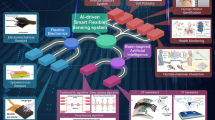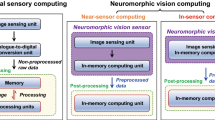Abstract
This paper presents a novel real-time robotic binaural sound localization method based on hierarchical fuzzy artificial neural networks and a generic set of head related transfer functions. The robot is a humanoid equipped with the KEMAR artificial head and torso. Inside the ear canals two small microphones play the role of the eardrums in collecting the impinging sound waves. The neural networks are trained using synthesized sound sources placed every 5° from 0° to 255° in azimuth, and every 5° from − 45° to 80° in elevation. To improve generalization, the training data was corrupted with noise. Thanks to fuzzy logic, the method is able to interpolate at its output, locating with high accuracy sound sources at positions which were not used for training, even in presence of strong distortion. In order to achieve high localization accuracy, two different binaural cues are combined, namely the interaural intensity differences and interaural time differences. As opposed to microphone-array methods, the presented technique, uses only two microphones to localize sound sources in a real-time 3D environment.
Similar content being viewed by others
References
Ajdler T, Sbaiz L and Vetterli M (2005). The plenacoustic function on the circle with application to HRTF interpolation. IEEE Int Conf Acoust Speech Signal Process 5: 824–839
Ben-Arie J and Rao K (1995). Nonorthogonal signal representation by Gaussians and Gabor Functions. IEEE Trans Circuits Syst 42: 402–413
Bernstein L, Trahiotis C, Akeroyd M and Hartung K (2001). Sensitivity to brief changes of interaural time and interaural intensity. J Acoust Soc Am 109: 1604–1615
Blauert J (1997). An introduction to binaural technology. In: Gilkey, R and Anderson, T (eds) Binaural and spatial hearing, pp 593–609. Lawrence and Erlbaum, Hillsdale
Colburn H and Latimer J (1978). Theory of binaural interaction based on auditory-nerve data, III. Joint dependence on inter-aural time and amplitude differences in discrimination and detection. J Acoust Soc Am 64: 95–106
Culling J and Colburn H (1986). Binaural sluggishness in the perception of tone sequences and speech in noise. J Acoust Soc Am 79: 1939–1949
Durlach NI (1963). Equalization and cancellation theory of binaural masking level differences. J Acoust Soc Am 35: 1206–1218
Grantham D (2000). Detection and discrimination of simulated motion of auditory targets in the horizontal plane. J Acoust Soc Am 107: 517–527
Handzel A and Krishnaprasad P (2004). Biomimetic sound-source localization. Inf Fusion (Special Issue on Robust Speech Processing) 5: 131–140
Holmström L and Koistinen P (1992). Using additive noise in back-propagation training. IEEE Trans Neural Netw 3: 24–38
Itakura Laboratory (1999) Database of head related transfer functions. http://www.itakura.nuee.nagoya-u.ac.jp
Jahromi O and Aarabi P (2005). Theory and design of multirate sensor arrays. IEEE Trans Signal Process 53: 1739–1753
Jefress LA (1957). A place theory of sound localization. J Comp Physiol Psychol 61: 468–486
Keyrouz F, Diepold K (2006) A rational HRTF interpolation approach for fast synthesis of moving sound. In: IEEE digital signal processing workshop, Whyoming, pp 222–226
Keyrouz F, Naous Y, Diepold K (2006a) A new method for binaural 3D localization based on HRTFs. In: IEEE international conference on acoustics, speech and signal processing (ICASSP), Toulouse, pp 341–344
Keyrouz F, Diepold K, Dewilde P (2006b) Robust 3D robotic sound localization using state–space HRTF inversion. In: IEEE international conference on robotics and biomimetics (ROBIO), China, pp 245–250
Keyrouz F, Maier W, Diepold K (2007) Robust localization and separation of concurrent sound sources using self-splitting competitive learning. In: First IEEE symposium on computational intelligence in image and signal processing (CIISP), Hawai
Makous J and Middlebrooks J (1990). Two-dimensional sound localization by human listeners. J Acoust Soc Am 87: 2188–2199
Minaar P, Plogsties J and Christensen F (2005). Directional resolution of head-related transfer functions required in binaural synthesis. J Audio Eng Soc 53: 919–929
Nakashima H and Mukai T (2005). 3D Sound source localization system based on learning of binaural hearing. IEEE Int Conf Syst Man Cybern 4: 3534–3539
Nandy D and Ben-Arie J (1996). An auditory localization model based on high frequency spectral cues. Ann Biomed Eng 24: 824–839
Wang QH, Ivanov T and Aarabi P (2004). Acoustic robot navigation using distributed microphone arrays. Inf Fusion (Special Issue on Robust Speech Processing) 5: 131–140
Xiawei Y, Kuansan W and Shamma S (1992). Auditory representations of acoustical signals. IEEE Trans Inf Theory 38: 824–839
Author information
Authors and Affiliations
Corresponding author
Additional information
This work is fully supported by the German Research Foundation (DFG) within the collaborative research center SFB453 “High-Fidelity Telepresence and Teleaction”.
Rights and permissions
About this article
Cite this article
Keyrouz, F., Diepold, K. A novel biologically inspired neural network solution for robotic 3D sound source sensing. Soft Comput 12, 721–729 (2008). https://doi.org/10.1007/s00500-007-0249-9
Published:
Issue Date:
DOI: https://doi.org/10.1007/s00500-007-0249-9




